Trending
Winter storm warning for 9 states as millions told: Don’t leave home
Published
1 day agoon
By
Ekwutos Blog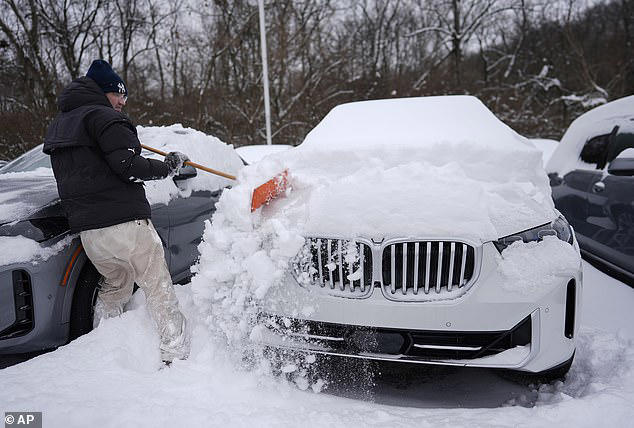
As Winter Storm Cora barrels toward the southern US, nine states are closing schools, stocking up on supplies and preparing for dangerous roads.
The National Weather Service (NWS) has issued winter storm watches and warnings for large swaths of Texas, Oklahoma, Arkansas, Louisiana, Mississippi, Alabama, Georgia, Kentucky and the entire state of Tennessee.
Snow and ice will create travel mayhem from Texas to the Carolinas and Virginia, including in and around Dallas-Fort Worth, Nashville, Atlanta and other cities, according to The Weather Channel.
AccuWeather stated that the risk of a significant ice storm could trigger widespread power outagesis increasing for parts of northeastern Texas to northern Louisiana and southern Arkansas.
‘Persons should delay travel if possible. If travel is absolutely necessary, drive with extreme caution and be prepared for sudden changes in visibility,’ the NWS advised in a Wednesday morning update.
The warning comes as a person was found frozen to death at a bus stop in Houston, Texas during a winter storm that hit earlier this week.
The heaviest snowfall will hit far northern Texas and southeast Oklahoma into Arkansas, northern Mississippi, northern Alabama, northern Georgia, southern Tennessee and extreme western North Carolina, including in Dallas and Little Rock.
‘Should 6 inches of snow fall in Dallas, it would be in the top-five snowfalls on record,’ AccuWeather Senior Director of Forecasting Operations Dan DePodwin said.
Six to 12 inches of accumulation are possible for this area, according to AccuWeather.
Storm Cora is predicted to move into the South Plains Wednesday evening and linger until Thursday, with the wintry mix dissipating midday Friday.
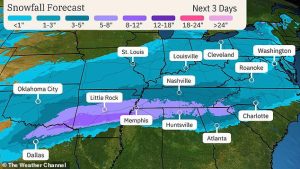
As Winter Storm Cora barrels toward the southern US, nine states are closing schools, stocking up on supplies and preparing for dangerous roads
‘Leave plenty of room between you and the motorist ahead of you, and allow extra time to reach your destination, the agency added.
‘Avoid sudden braking or acceleration, and be especially cautious on hills or when making turns. Make sure your car is winterized and in good working order.’
South of the storm’s main band, a few inches of snow and sleet may accumulate in areas near and north of Atlanta in Georgia, Greenville in South Carolina and North Carolina’s Charlotte.
Elsewhere, light snow totals of a dusting to a few inches are expected from southern Kansas and Missouri to the Ohio Valley, the Great Lakes and the Northeast.
The storm will begin with some areas of light snow, freezing rain and sleet developing in the Southern Plains.
Parts of northern Texas, Oklahoma, Arkansas, southern Kansas and southwestern Missouri could see snow Wednesday night into Thursday, while sleet and freezing rain may stretch from central Texas into northern Louisiana and southern Arkansas.
By Thursday, driving could be hazardous in Oklahoma City, Tulsa, Dallas-Ft. Worth, Little Rock and the Texas Hill Country, The Weather Channel reported.
Wintry precipitation should taper off in Texas and Oklahoma by midday Friday, but snow will spread further east into Kentucky, Tennessee, northern Mississippi, Alabama, Georgia, North Carolina and upstate South Carolina.
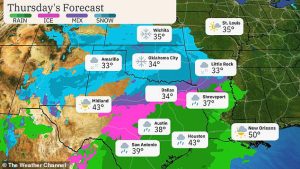
By Thursday, driving could be hazardous in Oklahoma City, Tulsa, Dallas-Ft. Worth, Little Rock and the Texas Hill Country, The Weather Channel reported.
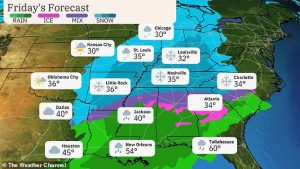
Wintery precipitation should taper off in Texas and Oklahoma by midday Friday, but snow will spread further east into Kentucky, Tennessee, northern Mississippi, Alabama, Georgia, North Carolina and upstate South Carolina
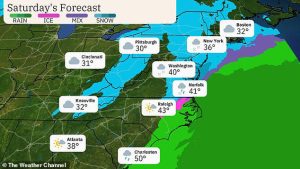
Heading into the weekend, the storm will move into the mid-Atlantic and Northeast, with areas of snow lingering near the Eastern Seaboard and in the Appalachians early Saturday
A wintery mix of snow, sleet and freezing rain could hit near and north of Interstate 20 from northern Louisiana to Georgia and South Carolina.
‘This could lead to treacherous travel throughout these areas, with some roads possibly becoming impassable, especially in hilly or mountainous terrain,’ meteorologists for The Weather Channel stated.
Travel will be hazardous in the cities of Atlanta, Birmingham, Charlotte, Huntsville, Little Rock, Memphis and Nashville for at least part of Friday.
Heading into the weekend, the storm will move into the mid-Atlantic and Northeast, with areas of snow lingering near the Eastern Seaboard and in the Appalachians early Saturday.
Especially in the early morning, travel will be difficult from northern Georgia to parts of South Carolina, North Carolina and Virginia.
As the weekend comes to an end, the storm will move offshore and into the Atlantic, but could track as far north as southern New England before doing so, according to AccuWeather.
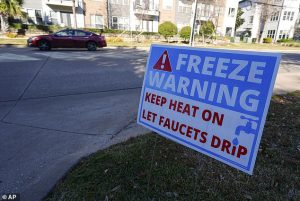
A freeze warning sign stands outside of an apartment complex in North Texas as the area braces for Winter Storm Cora
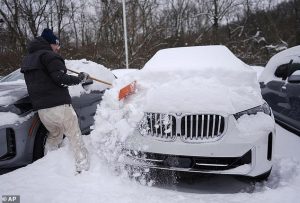
Cora comes as the combined impact of the Arctic blast and Winter Storm Blair, which wreaked havoc on the Ohio Valley and mid-Atlantic this week (pictured)
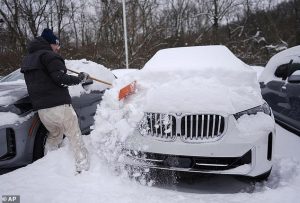
Meanwhile, fast-moving wildfires are engulfing the Los Angeles area, triggered by a powerful Santa Ana windstorm that swept Southern California Tuesday
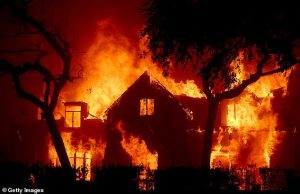
Winter Storm Cora comes as the eastern US faces a blast of Arctic air that will send temperatures plummeting as low as 30 to 40 degrees Fahrenheit below average in the first two weeks of January, according to AccuWeather.
The area most impacted by these frigid temps will be the northern Plains and Midwest to the interior Southeast.
As of Tuesday, the combined impact of the Arctic blast and Winter Storm Blair, which wreaked havoc on the Ohio Valley and mid-Atlantic this week, has already claimed the lives of at least six people.
The majority of these deaths were related to traffic accidents, but one victim was found frozen to death at a bus stop in Houston, Texas.
As of 10am ET Wednesday, more than 60,000 customers are still without power in Indiana, Kentucky, Virginia and West Virginia, according to PowerOutage.us.
Meanwhile, fast-moving wildfires are engulfing the Los Angeles area, triggered by a powerful Santa Ana windstorm that swept Southern California Tuesday.
Nearly 250,000 customers are out of power, and mandatory evacuations have been ordered for more than 80,000 people.
More than 1,400 firefighters are working to contain multiple blazes, but at this time, the fires are zero percent contained.
You may like
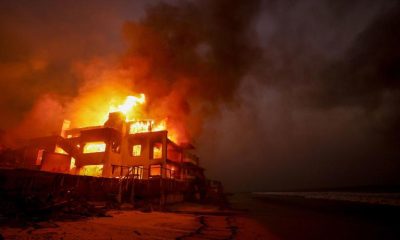

California wildfires: Why are they happening and is climate change to blame?


Edinburgh’s tourist tax is launching in 2026. Here’s how much visitors will have to pay


Horner: Red Bull has the “strength” to deal with Newey, Wheatley exits
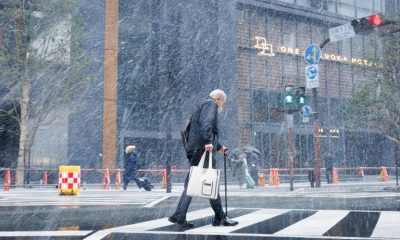

Heavy snow strikes southwest Japan as weather agency issues snowstorm warnings


Retired Military Personnel Block Finance Ministry Over Unpaid Entitlements


Social Media Erupts as Janemena and Korra Obidi’s Risqué Nightclub Outfits Spark Controversy
Trending
California wildfires: Why are they happening and is climate change to blame?
Published
43 mins agoon
January 9, 2025By
Ekwutos Blog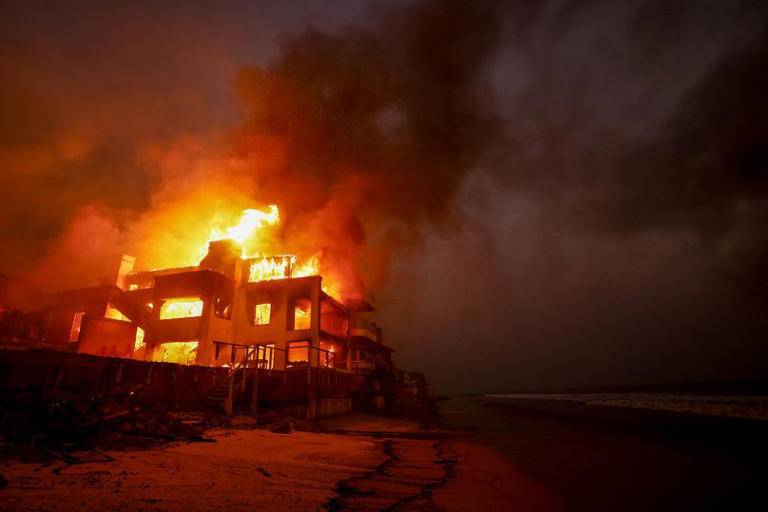
Southern California is experiencing its most devastating winter fires in more than four decades.
Fires don’t usually blaze at this time of year, but specific ingredients have come together to defy the calendar in a fast and deadly manner.
Behind many of them lies human-induced climate change.
Scientists have calculated that global warming has contributed to a 172 per cent increase in areas torched by wildfires in California since the 1970s, with a further spread expected in the coming decades.
What is causing winter wildfires in California?
A cocktail of extreme weather events has fanned California’s fires.
First are the supersized Santa Ana winds whipping flames and embers at 100 mph (161 kmh) – much faster than normal – crossed with the return of extreme drought.
Added to that is weather whiplash that grew tons of plants in downpours and then the record-high temperatures that dried them out to make easy-to-burn fuel.
Then there’s a plunging and unusual jet stream, and lots of power lines flapping in the powerful gusts.
Experts say that this perilous combination is what is turning wildfires into a deadly urban conflagration.
‘The big culprit is a warming climate’
“Tiny, mighty and fast” fires have blazed through America’s west in the last couple of decades as the world warms, said University of Colorado fire scientist Jennifer Balch.
She published a study in the journal Science last October that looked at 60,000 fires since 2001 and found that the fastest-growing ones have more than doubled in frequency since 2001 and caused far more destruction than slower, larger blazes.
“Fires have gotten faster,” Balch said on Wednesday. “The big culprit we’re suspecting is a warming climate that’s making it easier to burn fuels when conditions are just right.”
Summer fires are usually bigger, but they don’t burn nearly as fast. Winter fires “are much more destructive because they happen much more quickly”, said US Geological Survey fire scientist Jon Keeley.
AccuWeather estimated damage from the latest fires could reach $57 billion (€55 billion), with the private firm’s chief meteorologist, Jonathan Porter, saying “it may become the worst wildfire in modern California history based on the number of structures burned and economic loss”.
Winds brought by jet stream have fanned the flames
“It’s really just the perfect alignment of everything in the atmosphere to give you this pattern and strong wind,” said Tim Brown, director of the Western Regional Climate Center.
Wind speed and the speed of spreading flamesare clearly linked, experts emphasise.
“The impact increases exponentially as wind speed increases,” said fire scientist Mike Flannigan of Thompson Rivers University in Canada.
If firefighters can get to the flames within 10 minutes or so, its spread can be contained, but “15 minutes, it’s too late and it’s gone. The horse has left the barn”.
There’s no sure link between Santa Ana winds – gusts from the east that come down the mountains, gain speed and hit the coast – to human-caused climate change, said Daniel Swain, climate scientist for the California Institute for Water Resources.
But a condition that led to those winds is a big plunge in the temperature of the jet stream – the river of air that moves weather systems across the globe – which helped bring cold air to the eastern two-thirds of the nation, said University of California Merced climate and fire scientist John Abatzoglou.
Other scientists have preliminarily linked those jet stream plunges to climate change.
Santa Ana winds are happening later and later in the year, moving more from the drier fall to the wetter winter, Keeley said. Normally, that would reduce fire threats, but this isn’t a normal time.
‘Clear link between climate change and dry winters’
After two soaking winters, when atmospheric rivers dumped huge amounts of water on the region causing lots of plants to grow, a fast onset of drought dried them out, providing perfect tinder, according to Swain and Abatzoglou.
Swain said this weather whiplash is happening more often.
There is a clear link between climate change and the more frequent dry falls and winters that provide fuel for fires, Swain said.
These devastating fires couldn’t happen without the dry and hot conditions, nor would they be blazing without the extreme wind speed, according to Abatzoglou and others.
California’s average temperature has risen by around 1C since 1980 causing the number of days with fire-vulnerable dry vegetation to double, fire management expert Lindon Pronto at the European Forest Institute told Irish news site RTÉ News.
‘Now we talk about fire years’
An analysis of 423 California wildfires that have grown to at least 15 square miles (39 square kilometres) since 1984 shows only four of those burned during the winter. About two-thirds of those larger fires sparked in June, July or August.
Federal data shows just six wildfires have burned more than 2 square miles (5 square kilometres) in any January in California since 1984.
Until the Palisades and Eaton fires this year, the largest had been the Viejas Fire, which burned 17.1 square miles (44.3 square kilometres) in 2001 in the mountains east of San Diego.
“Winter wildfires should be an oxymoron,” University of Colorado’s Balch said. “Well, because, you know, temperatures drop and we get precipitation. We’re supposed to get precipitation.”
Fire officials used to talk about fire seasons, said David Acuña, a battalion chief for Cal Fire: “Now we talk about fire years”.
Trending
Heavy snow strikes southwest Japan as weather agency issues snowstorm warnings
Published
10 hours agoon
January 9, 2025By
Ekwutos Blog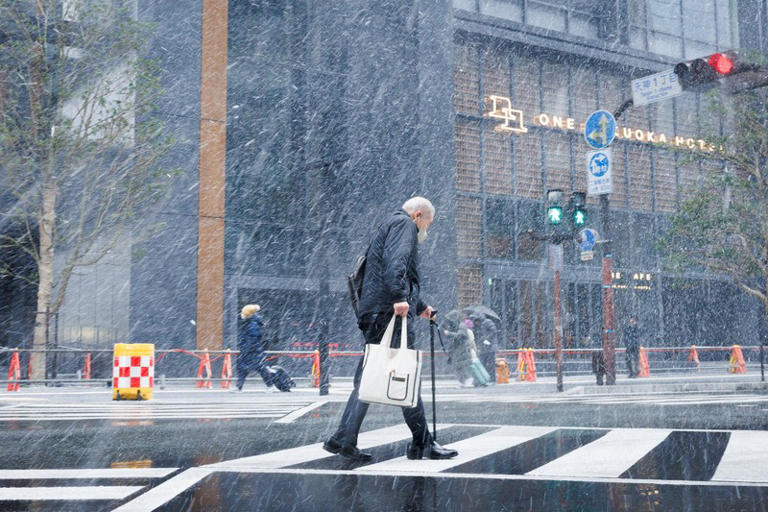
FUKUOKA — The Japan Meteorological Agency issued snowstorm warnings for ocean areas off the Fukuoka region that includes this southwest Japan city and Hibikinada Sea off Kitakyushu on the morning of Jan. 9, as a cold air mass sweeping over the country brought snow to the northern Kyushu region.
The Fukuoka District Meteorological Observatory warned of strong winds with snow and called for people to be on the lookout for traffic disruptions due to accumulated snow and icy roads.
Starting in the morning, heavy snow fell intermittently in central Fukuoka and people, some with umbrellas, were seen hurrying through the city’s bustling Tenjin district as snow swirled around them.
According to the local meteorological observatory, a cold air mass with temperatures dropping below minus 12 degrees Celsius — the most severe this season — is expected to flow into the northern Kyushu region at an altitude of approximately 1,500 meters through Jan. 10, intensifying the winter pressure pattern. Over the 24-hour period up to 6 a.m. on Jan. 10, the region, excluding Yamaguchi Prefecture, is expected to receive up to 10 centimeters of accumulated snow in mountainous regions and 5 cm on plains.
(Japanese original by Azusa Yamazaki, Kyushu News Department)
Trending
Chloe Bailey recently opened up about her whirlwind trip to Lagos, Nigeria, and those persistent rumors about a romantic connection with Burna Boy.
Published
22 hours agoon
January 8, 2025By
Ekwutos Blog
Chloe Bailey recently opened up about her whirlwind trip to Lagos, Nigeria, and those persistent rumors about a romantic connection with Burna Boy.
In a candid interview, Bailey shared her enthusiasm for the city, describing it as a “beautiful experience” that left an indelible mark on her. She was particularly taken by the city’s vibrant energy, warm people, and rich cultural heritage.
As for the rumors surrounding her relationship with Burna Boy, Bailey chose to address them with a mix of humor and diplomacy. When questioned about the nature of their relationship, she playfully dismissed the speculation, stating that they’re simply “cool” and that she has immense respect for his talent. Despite the intrigue surrounding their interactions, Bailey’s response suggests that their connection is rooted in mutual admiration and respect, rather than romance.
Photo source: Instagram






California wildfires: Why are they happening and is climate change to blame?

Edinburgh’s tourist tax is launching in 2026. Here’s how much visitors will have to pay

Horner: Red Bull has the “strength” to deal with Newey, Wheatley exits
Trending
- Politics11 months ago
Nigerian Senate passes Bill seeking the establishment of the South East Development Commission.

 Business11 months ago
Business11 months agoInflation hits record high of 29.90% on naira weakness

 Politics7 months ago
Politics7 months agoBREAKING: Federal Gov’t Offers To Pay Above N60,000, Reaches Agreement With Labour

 SportsNews10 months ago
SportsNews10 months agoOlympic Qualifiers 2024: CAF Confirms Dates For Super Falcons Vs Banyana Banyana

 Politics10 months ago
Politics10 months agoGovernor Hope Uzodinma’s New Cabinet In Imo: The Gainers, The Losers
- Entertainment11 months ago
American Singer Beyonce makes history as first Black woman to top country chart

 Trending3 months ago
Trending3 months agoNYA demands release of ‘abducted’ Imo chairman, preaches good governance
- Business3 months ago
US court acquits Air Peace boss, slams Mayfield $4000 fine

